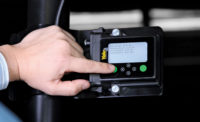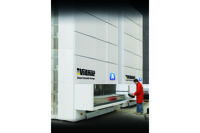The recession hit the cold food industry hard. And now, Mother Nature’s crazy antics are skewing the way food processors produce food. Combine these unfortunate circumstances with the ever-changing food safety regulations, and it’s a wonder the cold food industry ever finds a way to reclaim itself.
Thankfully the lift truck industry developed a host of new products designed to give the cold food industry that edge necessary to work smarter, not just harder. Today’s new technologies feature operator comfort, flexible designs and the ability to maneuver more efficiently in tight spaces.
Here’s a rundown of newly introduced lift trucks that help the cold food industry advance to new levels.
Withstanding harsh environments
“Food processors continue to need lift truck products that can withstand the rigors of washdown environments and still deliver the efficiency of moving the food product around the operation,” says David McNeill, warehouse product manager for Yale Materials Handling Corp., Greenville, N.C.
In response to cold processors’ needs, Yale introduced the MPB045-VG heavy-duty walkie pallet truck featuring Yale’s patented Smart Lift technology, which is said to reduce cycle times by up to 25%. Smart Lift automatically permits the pallet to rise to maximum fork height without the operator having to continually hold the lift button, creating simultaneous lift and travel. The truck can also be equipped with Yale’s industry exclusive Smart Slow Down technology. When the operator turns the truck during cornering, this feature automatically reduces the truck’s speed, enabling the operator to maneuver through the warehouse with increased confidence.
Maneuvering through tight areas
Yale also unveiled the Yale ERP025-030VC 3-wheel sit-down electric lift truck, designed with a narrow width and tight turning radius, allowing operators to maneuver more efficiently in constricted areas or congested loading docks. The series offers 2,500 or 3,000 pounds of lifting capacity, making them ideal for light manufacturing, food processing, third-party logistics and distribution applications. Both models are equipped with AC motors, a rear wheel drive motor, single steer tire, drum brakes and a manual parking brake.
Additionally, Yale launched the Yale ERP080-100VM electric-powered lift truck series. This sit-down, electric-powered, pneumatic tire lift truck series is available in 8,000-, 9,000-and 10,000-pound models. It uses auto deceleration, which reduces brake wear and extends brake life by automatically slowing the truck through regenerative braking. In addition, the trucks’ oil-cooled wet disc brakes are completely sealed from water and other contaminants, translating to more time on the warehouse or plant floor instead of in the shop. The Yale ERP080-100VM also features a “Drop Battery Box” design—a low seat position and low step height, allowing operators to effortlessly enter and exit the truck.
Lastly, Yale released the Yale MO50T tow tractor Guided, manufactured by Seegrid Corp., Pittsburgh, Pa. The Yale MO50T tow tractor requires no additional infrastructure for navigation. An operator trains the vehicle by driving a desired route while programming selected behaviors. During training, the vision system captures images of the environment and compiles the images into a 3D map for route navigation. The vehicle can learn and store up to 25 miles of routes.
For its part, Crown Equipment Corp., New Bremen, Ohio, developed the Crown ST 3000-25 Series walkie straddle stacker, which is capable of handling up to 2,500 pounds and works in environments with tight spaces, such as grocery and retail. The stacker’s compact design combined with Crown’s exclusive X10 Handle is a key reason why it can maneuver in small spaces. The durable, cast aluminum control handle features advanced ergonomics. A brake override feature ensures accurate maneuvering when the handle is in the near-vertical position. This allows the stacker to easily turn in an area almost as small as its own footprint and reduces the risk of damage to the truck, load and facility. The stacker’s low-profile power unit and clear mast design gives operators a clear view while working with elevated loads or moving products throughout the facility.
Automation automatically
Seegrid launched the GWS35, a patented vision-guided autonomous navigation system that automatically picks, drops, stacks and puts away loads up to 72 inches at a maximum load capacity of 3,500 pounds. The GWS35 is state of the art yet simple to use, as it does not require any additional infrastructure, costly expansion, redesign into a facility or a specialized team of engineers to install, support or operate.
“When manned forklifts are replaced with an automated solution, worker safety is greatly increased,” says Amanda Merrell, marketing director. “Vision-guided automated guided vehicles (AGVs) improve worker safety and also aide in reducing product damage. Removing the operator from the forklift automatically eliminates the decision-making process from all aspects of transportation.”
Meanwhile, Crown Equipment introduced QuickPick Remote System, a game-changing innovation in low-level order picking. With the simple press of a button on the wireless remote, the order selector remotely advances the truck to the next pick location, allowing the operator to remain in the optimum pick position. Using patent-pending technologies, the transceiver glove boasts a thumb-actuated button that allows operators to remotely advance the truck to the next pick slot. Each module has a unique identification code, so that only one truck is operated at a time.
Heavy duty, heaving lifting
“Refrigerated and frozen food processing is a very challenging lift truck environment, from washdowns to quick temperature swings to tight spaces—all with operational productivity and profitability hinging on the lift truck,” says Lou Micheletto, warehouse integrated solutions manager for Hyster Co.
That’s why the Greenville, N.C., manufacturer introduced a bevy of material handling solutions. For example, the new W45ZHD heavy-duty walkie pallet truck utilizes a heavy-duty fork frame and linkage with HTX bushings. The heavy duty steel drive frame coupled with a highly engineered drive unit casting make this one of the heaviest drive unit frames in the industry, according to Hyster. To improve productivity, the W45ZHD walkie is available with Hyster’s patented Intelligent Lift technology, which is said to improve operator productivity up to 25% by allowing operators to simultaneously transport and lift pallets. Trucks equipped with this technology will automatically lift the pallet to the maximum fork height, without continually having to hold the lift button during transport. Another industry exclusive feature is Hyster’s Intelligent Slow Down, which recognizes when the operator turns the truck during cornering and automatically decreases speed. This feature allows the unit to be placed in turtle function in all handle run zones, minimizing the truck profile and improving maneuverability.
Hyster also equips its lift trucks with a telemetry system called Hyster Tracker. This wireless asset management system provides three levels of management—wireless monitoring, wireless access and wireless verification—and offers a variety of monitoring capabilities, including hour meter and fault code tracking, cost of operations, impact sensing, access control, automatic shutdown and operator pre-shift checklist.
“Technology continues to be a driving force in the lift truck industry and equipment is getting more intelligent,” says Micheletto. “To remain a leader, we offer innovations that anticipate and then meet our customers’ needs.”
Furthermore, Toyota Material Handling, U.S.A., Inc. (TMHU), Columbus, Ind., launched its new 8-Series Electric Stand-Up Rider Counterbalance forklifts. Available in 3,000- to 4,000-pound lifting capacities, the new line features Toyota’s innovative AC technology, resulting in better travel speeds, consistency in performance throughout the battery charge and reduced maintenance costs. The forklifts are ideal for use in general warehouse and storage operations and all operations needing a dock-to-stock solution for multi-tasking functions and constant loading and unloading.
Lastly, Mitsubishi Caterpillar Forklift America Inc. (MCFA), Houston, Texas, created the new Jungheinrich EFG 540k-S50 series of electric pneumatic tire forklifts. Featuring advanced technology for increased efficiency and productivity, the 8,000- to 11,000-pound capacity forklift series offers operators the ability to work up to two shifts on one battery charge in most applications.
“As a standard design feature, the latest Jungheinrich reach trucks utilize fully-sealed electric controllers and connectors,” says Steve Rogers, senior product marketing specialist. “This is especially important after a lift truck comes out of a cooler or freezer into the warmer air of the dry goods warehouse. As the reach truck warms up, water will condense on the metal surfaces, then drip down all surfaces. Since the important electrical items are sealed, they are impervious to this water condensation.”
Improved operator comfort
Crown Equipment also answers the call for improved operator comfort.
“Given the especially harsh demands of frozen and refrigerated environments, the productivity challenges often come down to equipment durability and operator comfort,” says Andy Smith, general manager, marketing product management for Crown Equipment.
That’s why Crown introduced the Crown TSP 7000 and TSP 6500 Series Turret trucks featuring the company’s innovative MonoLift mast. The Crown TSP Series helps operators complete more cycles over time and helps place most loads at open slots at any height, all while traveling in a tight aisle with less than 6 inches of clearance. The rigid design of the MonoLift mast is rooted in a boxed-in cross section construction that significantly minimizes twisting and swaying, providing greater stability and higher heights. These turret trucks feature a main lift speed of 120 feet per minute. They are also said to deliver a 25% advantage in travel speed, and can complete a full traverse in only five seconds and pivot a full 180 degrees in six seconds.
Meanwhile, the Raymond Corp., Greene, N.Y., keeps operators warm thanks to its Raymond ThermaKit system, which provides a heated control handle and floor pad inside the lift truck.
MCFA released the Jungheinrich EFG-ETM, a moving mast reach truck model that includes a heated “closed cabin” option, which enables the operator to wear normal clothes, yet operate the reach truck in as little as -30°C environments.
“Without this option, operators usually limit their time in the freezer to 15-20 minutes before they have to come out of the freezer to warm up. This results in a loss of productivity throughout the shift,” says Rogers. “With the Jungheinrich closed cabin, the operator can continue to operate when other trucks would sit idle.”
The cold food industry should have no fear. Despite increasing food safety regulations and Mother Nature’s curveballs, the lift truck industry continues to experience an upswing, helping food manufacturers and cold storage providers advance to new levels.
Charging Stations Give Lift Trucks Quite a Boost
As the lift truck industry evolves, so does the way they charge their batteries.
For example, Crown Equipment Corp., New Bremen, Ohio, continued development of its high-efficiency charger line—the V-Force High Frequency Modular Series Charger—so the user can maximize charger performance.
“Features like the Battery Monitor Identification Device allow the charger to monitor key system levels like temperature and cell voltage to provide precise control over the charge profile, preventing over- and under-charging to maximize battery life and charger efficiency,” says Andy Smith, general manager, marketing product management.
Crown’s V-HFM Series is adaptable to any voltage or amp-hour configuration and allows chargers to act as “fueling stations.” “By placing these [chargers] in popular staging areas in a customer facility, they can take advantage of additional charging opportunities throughout the day and help reduce the need to change batteries.”
Gone are the days of the old-fashioned battery. Today’s technologically advanced charging stations give lift trucks quite the boost.










